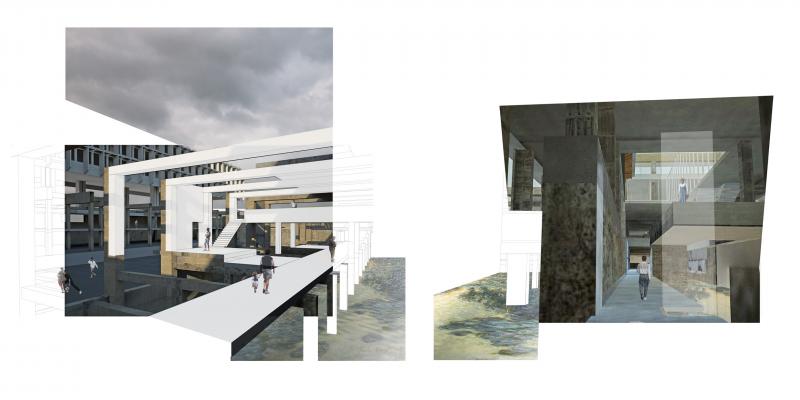Diploma 11 has been archiving leftover matter, unplanned sites and accidental architecture throughout London (Ed). These are expressions of times and places resulting in peculiar overlay of physical spaces (Raha). The redevelopment of Euston station is estimated to open up approximately 2.5 million square feet of predictably generic mixed-use development while increasing the number of platforms for a new High Speed 2 (HS2) railway that will connect the city to the Midlands and the North (Conrad).
The rebuild will have a direct impact on certain landmarks (Marko), but before any work has begun the repercussions are already affecting the area (Summer), and this uncertain future has left the neighbourhood, particularly the station itself, in a state of limbo. Physical decay is left unchecked as investment on piecemeal improvements becomes futile under the impending threat of demolition (Yannick). Our challenge is to define what makes up London today by sampling the city with careful consideration and investigating networks (Jonas), layers and levels of complexity that form its urban definition.
Our technique is the collage. By cutting and pasting, we reconfigure the existing and expect the unexpected (Max). We responded to a series of ‘what ifs?’ and proposed fixtures, fragments and forms that reveal, connect and cut through the essential matters of the existing fabric. Proposals derived from our research stand for continuity in the current reality of a market economy where the homogenisation caused by the likes of Starbucks and Holiday Inn has engulfed the city and transformed it with immense speed.
Our technical studies have continued to explore composite structures and material organisations that respond to the permanency and temporality inherent in Euston’s restructuring (Tom). Urban sampling extended to Nanjing China’s Xiaguan district and was juxtaposed with Euston as we suggested possibilities of how the local community around the abandoned train station can co-exist within the overall masterplan proposed by SOM (Xia). The unit plays a game of scales, materials, city stories and textures that are to be materialised in one design discourse (Jessica) – a counter proposal of sorts – in response to the overbearing sameness of the conventional masterplan (Yannick).
Unit Staff
Shin Egashira
Guest critics and thanks
Valentin Bontjes van Beek
Nicholas Boyarsky
Carlos Villanueva Brandt
Peter Carl
Javier Castañón
Homa Fajardi
David Greene
Hugo Hinsley
Ken Livingstone
Robert Mull
David Grahame Shane
Brett Steele
Sylvie Taher
Carolina Vallejo
Michael Weinstock
Georgie and Charlie Corry Wright
South East University Nanjing
Susan Chai
Hua Lee
Zhu Yuan
Yannick Guillen
A CIVIC RECLAMATION OF EUSTON STATION
How to address the stations abandon and Somers Town neglect, through a process of reverse engineering and re-appropriation of space.
The probable, yet uncertain arrival of HS2 to Euston has left the station in a state of limbo. Physical decay is left unchecked, as investment on piecemeal improvements become futile under the impending threat of demolition. The general abandon is aggravated by the aggressive commercialization of space, driven by Network Rail’s capitalization on profit. This results in an over-crowded and dysfunctional space, cluttered with advertisement and retail units, confusing and unpleasant for the average passenger. Beyond the station’s hermetic walls, the community of Somers Town suffers from a similar neglect. Its predominantly council-tenant residents are faced with chronic income, employment and health deprivation, as well as poor education, skills and training opportunities.
The project seeks to address both the stations abandon and Somers Town neglect, through a process of reverse engineering and re-appropriation of space. Euston, along with the old Post sorting deck above the platforms, will be stripped down to its basic services, from waste management, to train watering and catering systems. These will be re-circuited so as to choreograph phenomena in the ‘released’ spaces, designed for the Somers Town community; from sports and education facilities, offering spaces of overlap between a marginalized youth and nearby UCL alumni, to market spaces and shelter for the most vulnerable. With the eventual arrival of HS2, only a fraction of the station will be demolished, and will attach itself along a pre-established boundary, doubling as a rainwater collection system for the whole station. This ‘occupation’ of infrastructure by local residents hints at the vision with which the station was conceived, built and designed by a public body, for the public, in an era of brave civic architecture.
.jpg)


































































